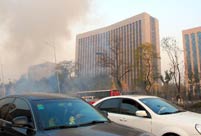GROWTH ENGINE VS SOCIAL INNOVATION
Although the six new areas have their own different focuses in development, they all bear the same mission of providing impetus to the regional economies as growth engines.
Established in September last year, the youngest Nansha New Area in Guangzhou, Guangdong Province, is expected to lead industrial restructuring in the Pearl River Delta and serve as an important platform for cooperation between Guangdong and neighboring Hong Kong and Macao special administrative regions.
Meanwhile, Lanzhou New Area in northwest China's Gansu Province marks the country's latest effort to accelerate the development of its western regions and is key for China's further opening of its west.
Cutting-edge high-end industries have been brought into these areas, indicating their higher standards in developing the regional economy.
While economic restructuring and upgrading have been prioritized within these areas, social innovation to better people's livelihood is also given the same consideration.
Comprehensive reforms regarding education, healthcare, housing and environmental protection have been pushed forward along with economic growth.
Chongqing's Liangjiang New Area, for example, is a pilot area for comprehensive urban-rural reform in the hopes of narrowing the gaps between cities and rural areas.
Nansha New Area has also earmarked some 200 square km of land along the coastline as areas that are not permitted for economic development so as to preserve the primitive ecosystem.
"The best coastlines in Nansha New Area will not give way to industrial production or construction. Instead, they will be reserved only for people's leisure," vowed Li Zigen, deputy head of the area's administrative committee.
Zhou Liqun, a professor with Nankai University, said the new areas have displayed their advantages in building an integrated urban-rural public service mechanism and upholding the ideology of environmental protection alongside development.
In addition to the state-level development areas, other pilot zones have been set up to test specific reforms.
Qianhai in Shenzhen City, which neighbors Hong Kong, has been designated as a test bed for China's financial opening up, after steps taken by the government to increase the international use of the yuan, the Chinese currency.
Moreover, Shanghai Free Trade Zone, launched at the end of September, will push financial reform to a new extent.
The forthcoming Third Plenary Session of the 18th CPC Central Committee, scheduled to run from Nov. 9 to 12 in Beijing, is expected to discuss major issues concerning comprehensive reform as China faces significant economic and social challenges.
Experts say the lessons and experience drawn from the six pilot new areas will lay a solid foundation and offer wisdom for the nation's strategic transformation in a new era.

 Fire guts 22-storey Nigeria commercial building in Lagos
Fire guts 22-storey Nigeria commercial building in Lagos U.S. Navy Carrier Strike Group stages military exercises
U.S. Navy Carrier Strike Group stages military exercises Volkswagen showcases new energy vehicles in Beijing
Volkswagen showcases new energy vehicles in Beijing  A girl takes care of paralyzed father for 10 years
A girl takes care of paralyzed father for 10 years A record of Beijing air quality change
A record of Beijing air quality change In pictures: explosions occur in Taiyuan
In pictures: explosions occur in Taiyuan Hello! Horror Halloween Celebration!
Hello! Horror Halloween Celebration!  The catwalk to the world of fashion
The catwalk to the world of fashion  Cruise trip to Taiwan
Cruise trip to Taiwan  Unveil PLA air force base
Unveil PLA air force base  Loyal dog waits for master for six months
Loyal dog waits for master for six months Oriental education or western education?
Oriental education or western education? China in autumn: Kingdom of red and golden
China in autumn: Kingdom of red and golden National Geographic Traveler Photo Contest
National Geographic Traveler Photo Contest Chinese screen goddesses from Beijing Film Academy
Chinese screen goddesses from Beijing Film Academy Day|Week|Month